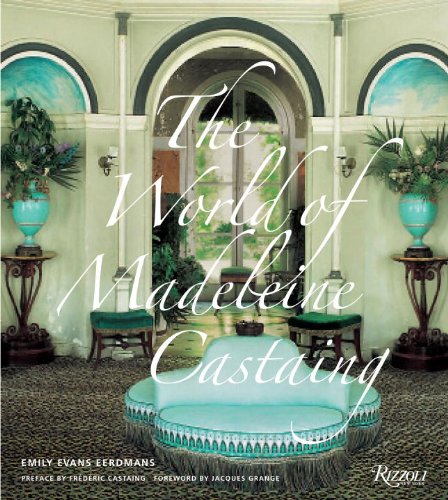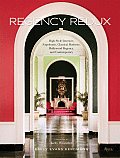A wall applique in the form of a Phyrgian helmet designed by Thomas Hope
Classicists are all aflutter over the current exhibition "Inspired by Antiquity: Classical influences on 18th and 19th century furniture and works of art" at Carlton Hobb's uptown mansion. The show is embarrassingly full of museum-worthy riches whose provenances are as notable as the objects themselves.
In fact, I have been bursting at the seams to show you this table which I first encountered on a tour of Carly's gallery months ago.
A royal porcelain demi-lune table by Bellangé, c. 1820, from Carlton House. Note how it's photographed in front of a mirror so that its reflection completes the ellipse.
It was installed in the Prince Regent's fabled Carlton House whose late Louis XVI-inspired decor of the 1790s set the London
beau monde on fire. The Prince, later George IV, earned a deserved reputation for extravagance and large sums were spent on constant redecorating. This table was acquired in 1822 for the Blue Velvet Room when the full-blown stylings of Walsh Porter had the monarch in its clutches.
The Blue Velvet Room, Carlton House, as painted by W.H. Pyne in 1818 - yet another scheme before the table was purchased
It is also interesting to note that the table is French in manufacture. The Regent had to curb his subversive Francophile ways during Britain's war with Napoleonic France, but the 1822 date of the table, well after the battle of Waterloo, suggests that nationalism was no longer an obstacle to sating his gout francais.
I was sworn to secrecy until now, as the table was being officially unveiled at this show. But this is only the tip of the iceberg.
Regency aesthete and designer Thomas Hope in Turkish costume
The cornerstone of the exhibition is the rare collection of Thomas Hope works painstakingly assembled by international art advisor
Philip Hewat-Jaboor. As all my fellow Regency-maniacs know, Thomas Hope was an enormously wealthy banking scion who, after taking the Grand Tour of all tours, returned to London determined to showcase his artifacts in a suitable, "Classically correct" setting.
Hope's Egyptian Room at Duchess Street. The Flaxman illustrations don't convey the brilliant color scheme of pale yellow and bluish green of the Egyptian pigment, relieved by masses of black and of gold"
The result was his fabulous and fabulously idiosyncratic house on Duchess Street, originally built by Robert Adam in the 1770s, and enlarged by Hope with the help of Charles Heathcote Tatham. Furniture and decorative objects necessary for the conveniences of modern life - but not found in ancient times - were designed by Hope himself.
Thomas Hope design for a wall light, left, and the carved and bronzed limewood wall light itself, c. 1802
Hope was so pleased with the results, he commissioned John Flaxman to illustrate the interiors which were published in 1807 as
Household Furniture and Interior Decoration. As Hewat-Jaboor has pointed out, Hope's ultimate mission was to improve taste and what better way than to lead by example.
Hewat-Jaboor also highlights Hope's lesson of combining new works with antiques, which he believes is as important in today's interiors as it was for Hope's. “You have to present things in a fabulous and exciting way, and that means there has to be a mixture of the very best – new and antique. You have to see how objects interact as a whole. It’s the fusion of paintings, objects and furniture that makes everything come alive."
Hewat-Jaboor's previous London flat with a pair of predestals and settee, both from Duchess Street and now on view at Carlton Hobbs
Hewat-Jaboor's Hope works were very much alive in his London residence, but, after a move, he found he no longer had the proper setting for them. "They are demanding pieces", he says, and it is undeniable that Hope's high style designs are not shrinking violets. Instead of relegating the collection to storage, Hewat-Jaboor is sending them off with this final valentine.
"Inspired by Antiquity" runs through February 18th
Carlton Hobbs
60 East 93rd Street
New York, NY
Tomorrow: More on Philip Hewat-Jaboor, the aesthete behind the aesthete
For more on the exhibition, click over to
1stdibs and the
Huffington Post.




























